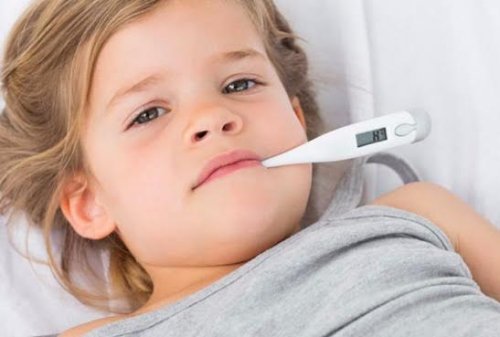Common Causes of Fever in Children

In children, fevers are actually very common, and you need how to control them quickly. This happens when kids have a higher body temperature than normal. The good thing is that, in most cases, you shouldn’t worry too much.
Having a fever isn’t a disease. On the other hand, it’s a symptom that your body is fighting an infection. In fact, it’s a protective mechanism that your body is trying to defend itself naturally.
When children have a fever, it might be difficult to identify what is causing it. Most of the time, fevers are the result of non-serious viral infections.
Lots of common infections in children cause a fever 48 hours before other symptoms appear. In this article, we’ll look at the most common causes of fever in children.
Possible causes of fever in children
Often, getting a fever is a normal reaction when children get an infection. Depending on the other symptoms, you can find out exactly what causes the fever. Then, you can act accordingly.
1. Viral infections
Infections from viruses in the body are the most common cause. In fact, this is usually the first symptom of viral infections. Additionally, you can easily spread them through contact.
This type of infection causes many common diseases, such as colds, coughs, the flu, or diarrhea. Sometimes, it can even cause more serious ones.
However, most viral infections in children last about 3 or 4 days. Other types of fevers can last longer because of the flu or diseases like mononucleosis.
2. Bacterial infections
Bacterial infections are less common than viral infections, but they’re one of the most common causes of fever in children. These types of bacteria are more likely to cause serious diseases.
For example, they can cause pneumonia, joint infections, urinary tract infections, kidney infections, sepsis and meningitis.

On the other hand, you need to remember that bacteria can cause fever in less serious infections, like ear infections and skin rashes.
3. Teething in babies
For babies, teething can also cause episodes of fever. This usually happens around six months when babies’ first teeth appear. When teeth push through the gums, this can cause a slight increase in body temperature, which causes fevers.
Also, older children can suffer from tooth abscesses, a painful bacterial infection that cavities cause. This could also cause children to have a fever.
4. Vaccinations as causes of fever in children
Occasionally, children develop a fever after getting vaccinations. In fact, many vaccines are designed to make the immune system think it sees an infection. That way, kids can develop immunity.
Usually, fevers from vaccines aren’t very high, and they don’t last very long. For most vaccines, fevers start after 24 hours and last for 1 or 2 days.
“When children have a fever, it might be difficult to identify what is causing it. Most of the time, fevers are from non-serious viral infections.”
5. Allergies
Symptoms of allergies usually include sneezing, watery eyes, runny nose, or even rashes. However, allergies alone don’t cause fevers.
On the other hand, sometimes, allergies make kids’ bodies more vulnerable to bacterial or viral infections. As we mentioned earlier, these can cause fevers.
6. Inflammatory diseases
Inflammation is one of the causes of fever in children. One of the most common inflammatory diseases that can cause fevers in children is rheumatic fever.
Keep in mind that inflammatory diseases can cause permanent heart damage and heart failure. In most cases, they affect kids from 5 to 15 years old.
7. Certain medications are causes of fever in children
As we mentioned earlier, some of the main causes of fever are bacterial and viral infections. However, certain medications can play a role.
Certain medications can actually cause fevers. In fact, this is a side effect of certain drugs. For example, antibiotics and systemic anti-infectives, non steroidal anti-inflammatory drugs and some medicinal herbs can cause fevers.

8. Other causes
In addition to everything we mentioned above, there are other causes of fever in children, like food poisoning, too much time in the sun, or intense physical activity under the sun.
Finally, fevers usually don’t require immediate medical intervention. In fact, most of the time, fevers go away on their own after 48 hours.
In children, fevers are actually very common, and you need how to control them quickly. This happens when kids have a higher body temperature than normal. The good thing is that, in most cases, you shouldn’t worry too much.
Having a fever isn’t a disease. On the other hand, it’s a symptom that your body is fighting an infection. In fact, it’s a protective mechanism that your body is trying to defend itself naturally.
When children have a fever, it might be difficult to identify what is causing it. Most of the time, fevers are the result of non-serious viral infections.
Lots of common infections in children cause a fever 48 hours before other symptoms appear. In this article, we’ll look at the most common causes of fever in children.
Possible causes of fever in children
Often, getting a fever is a normal reaction when children get an infection. Depending on the other symptoms, you can find out exactly what causes the fever. Then, you can act accordingly.
1. Viral infections
Infections from viruses in the body are the most common cause. In fact, this is usually the first symptom of viral infections. Additionally, you can easily spread them through contact.
This type of infection causes many common diseases, such as colds, coughs, the flu, or diarrhea. Sometimes, it can even cause more serious ones.
However, most viral infections in children last about 3 or 4 days. Other types of fevers can last longer because of the flu or diseases like mononucleosis.
2. Bacterial infections
Bacterial infections are less common than viral infections, but they’re one of the most common causes of fever in children. These types of bacteria are more likely to cause serious diseases.
For example, they can cause pneumonia, joint infections, urinary tract infections, kidney infections, sepsis and meningitis.

On the other hand, you need to remember that bacteria can cause fever in less serious infections, like ear infections and skin rashes.
3. Teething in babies
For babies, teething can also cause episodes of fever. This usually happens around six months when babies’ first teeth appear. When teeth push through the gums, this can cause a slight increase in body temperature, which causes fevers.
Also, older children can suffer from tooth abscesses, a painful bacterial infection that cavities cause. This could also cause children to have a fever.
4. Vaccinations as causes of fever in children
Occasionally, children develop a fever after getting vaccinations. In fact, many vaccines are designed to make the immune system think it sees an infection. That way, kids can develop immunity.
Usually, fevers from vaccines aren’t very high, and they don’t last very long. For most vaccines, fevers start after 24 hours and last for 1 or 2 days.
“When children have a fever, it might be difficult to identify what is causing it. Most of the time, fevers are from non-serious viral infections.”
5. Allergies
Symptoms of allergies usually include sneezing, watery eyes, runny nose, or even rashes. However, allergies alone don’t cause fevers.
On the other hand, sometimes, allergies make kids’ bodies more vulnerable to bacterial or viral infections. As we mentioned earlier, these can cause fevers.
6. Inflammatory diseases
Inflammation is one of the causes of fever in children. One of the most common inflammatory diseases that can cause fevers in children is rheumatic fever.
Keep in mind that inflammatory diseases can cause permanent heart damage and heart failure. In most cases, they affect kids from 5 to 15 years old.
7. Certain medications are causes of fever in children
As we mentioned earlier, some of the main causes of fever are bacterial and viral infections. However, certain medications can play a role.
Certain medications can actually cause fevers. In fact, this is a side effect of certain drugs. For example, antibiotics and systemic anti-infectives, non steroidal anti-inflammatory drugs and some medicinal herbs can cause fevers.

8. Other causes
In addition to everything we mentioned above, there are other causes of fever in children, like food poisoning, too much time in the sun, or intense physical activity under the sun.
Finally, fevers usually don’t require immediate medical intervention. In fact, most of the time, fevers go away on their own after 48 hours.
All cited sources were thoroughly reviewed by our team to ensure their quality, reliability, currency, and validity. The bibliography of this article was considered reliable and of academic or scientific accuracy.
- Vélez, J. A. C. (2001). Fiebre en niños. Ccap, 17–31.
- Ruiz Arcos, R., Cerón, M., Ruiz González, L., Segur, F. G., Valle Cervantes, G., Elizondo Villarreal, J. A., & Urbina-medina, H. (2010). Fiebre en pediatría. Revista Mexicana de Pediatría, 77(1), 3–8. Retrieved from http://www.medigraphic.com/rmp/
This text is provided for informational purposes only and does not replace consultation with a professional. If in doubt, consult your specialist.








